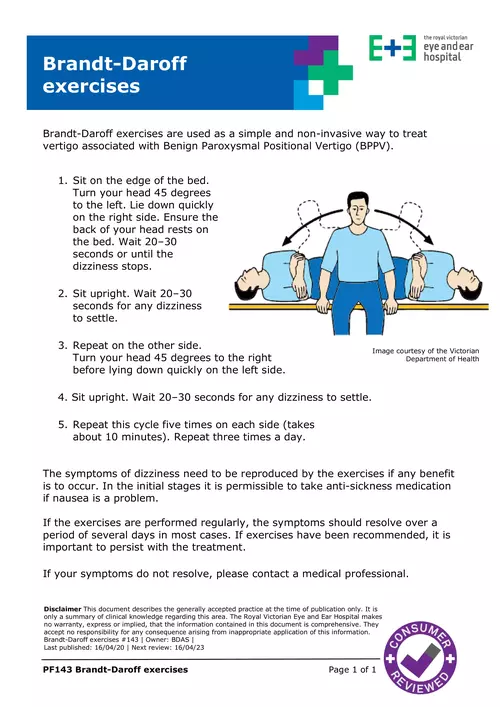
Brandt-Daroff exercises - Royal Victorian Eye and Ear Hospital
This leaflet has been produced to guide you through a self-treatment exercise for Benign Paroxysmal Positional Vertigo (BPPV). Your.
adsPart of the document
PF143 Brandt-Daroff exercises Page 1 of 1
Disclaimer This document describes the generally accepted practice at the time of publication only. It is only a summary of clinical knowledge regarding this area. The Royal Victorian Eye and Ear Hospital makes
no warranty, express or implied, that the information contained in this document is comprehensive. They
accept no responsibility for any consequence arising from inappropriate application of this information. Brandt-Daroff exercises #143 | Owner: BDAS |
Last published: 16/04/20 | Next review: 16/04/23
Brandt-Daroff exercises are used as a simple and non-invasive way to treat
vertigo associated with Benign Paroxysmal Positional Vertigo (BPPV).
1. Sit on the edge of the bed. Turn your head 45 degrees
to the left. Lie down quickly
on the right side. Ensure the
back of
your head rests on
the bed. Wait 20-30
seconds or until the
dizziness stops.
2. Sit upright. Wait 20-30
seconds for any dizziness
to settle.
3. Repeat on the other side. Turn your head 45 degrees to the right
before lying down
quickly on the left side.
4. Sit upright. Wait 20-30 seconds for any dizziness to settle. 5. Repeat this cycle five times on each side (takes
about 10 minutes). Repeat three times a day.
The symptoms of
dizziness need to be reproduced by the exercises if any benefit
is to occur.
In the initial stages it is permissible to take anti-sickness medication
if nausea is a problem.
If the exercises are performed regularly, the symptoms should resolve over a
period of sever
al days in most cases. If exercises have been recommended, it is
important to persist with the treatment.
If your symptoms
do not resolve, please contact a medical professional.
Image courtesy of the Victorian
Department of Health Brandt-Daroff
exercises


